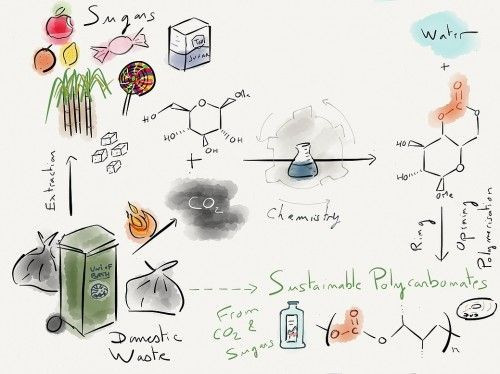Sugar In Your DNA Could Make Eco-Friendly Plastic To Cut Down Pollution

Scientists have designed a new, more biodegradable type of plastic that wouldn’t litter our oceans and beaches for hundreds of years — the more sustainable material is made of carbon dioxide and sugar and can break down within weeks.
“With an ever-growing population, there is an increasing demand for plastics,” researcher Antoine Buchard said in a statement from the University of Bath. “This new plastic is a renewable alternative to fossil fuel-based polymers, potentially inexpensive and, because it is biodegradable, will not contribute to growing ocean and landfill waste.”
Read: Plastic Pollution Chokes Even This Isolated, Uninhabited Island
Current plastics like the one used in soda and water bottles are a problem because they take so long to break down and are made using toxic chemicals. But the new material relies on sugar and carbon dioxide, which are significantly safer ingredients, and when the plastic bottle is done being used can be broken down back into carbon dioxide and sugar with “enzymes from soil bacteria,” the University of Bath said. And it can do more than just make drink containers; the more eco-friendly plastic is also biologically friendly, safe for use in medical implants and other items that will interact with human body parts.
According to the team’s two studies in the journal Polymer Chemistry and one in the journal Macromolecules, the carbon dioxide gas is used to transform the sugar into a polycarbonate without requiring a lot of heat or pressure.
“The resulting plastic has similar physical properties to those derived from petrochemicals, being strong, transparent and scratch-resistant,” the university said. “The new BPA-free plastic could potentially replace current polycarbonates in items such as baby bottles and food containers.”
The type of sugar involved in the process is not the same kind you would pour into a bowl in your kitchen — it’s a sugar called thymidine that is present in DNA. According to one of the Polymer Chemistry studies, sugars like this one are inexpensive and renewable because they have natural sources, origins which also makes them structurally and chemically diverse.
They have another benefit as well: “Because it is already present in the body, it means this plastic will be bio-compatible and can be used safely for tissue engineering applications” like creating artificial organs, researcher Georgina Gregory said. “The properties of this new plastic can be fine-tuned by tweaking the chemical structure — for example we can make the plastic positively charged so that cells can stick to it, making it useful as a scaffold for tissue engineering.”
Read: Can Caterpillars Eat All Our Plastic Waste?
The researchers are still working on making the plastic more durable for use in consumer products and on finding a way to reduce or reuse the waste that would be made from breaking it down.
Buchard said chemists are essentially going back to the beginning of plastic production science, starting from scratch to make new, sustainable plastics from more renewable ingredients.
“It’s early days, but the future looks promising.”
© Copyright IBTimes 2024. All rights reserved.





















